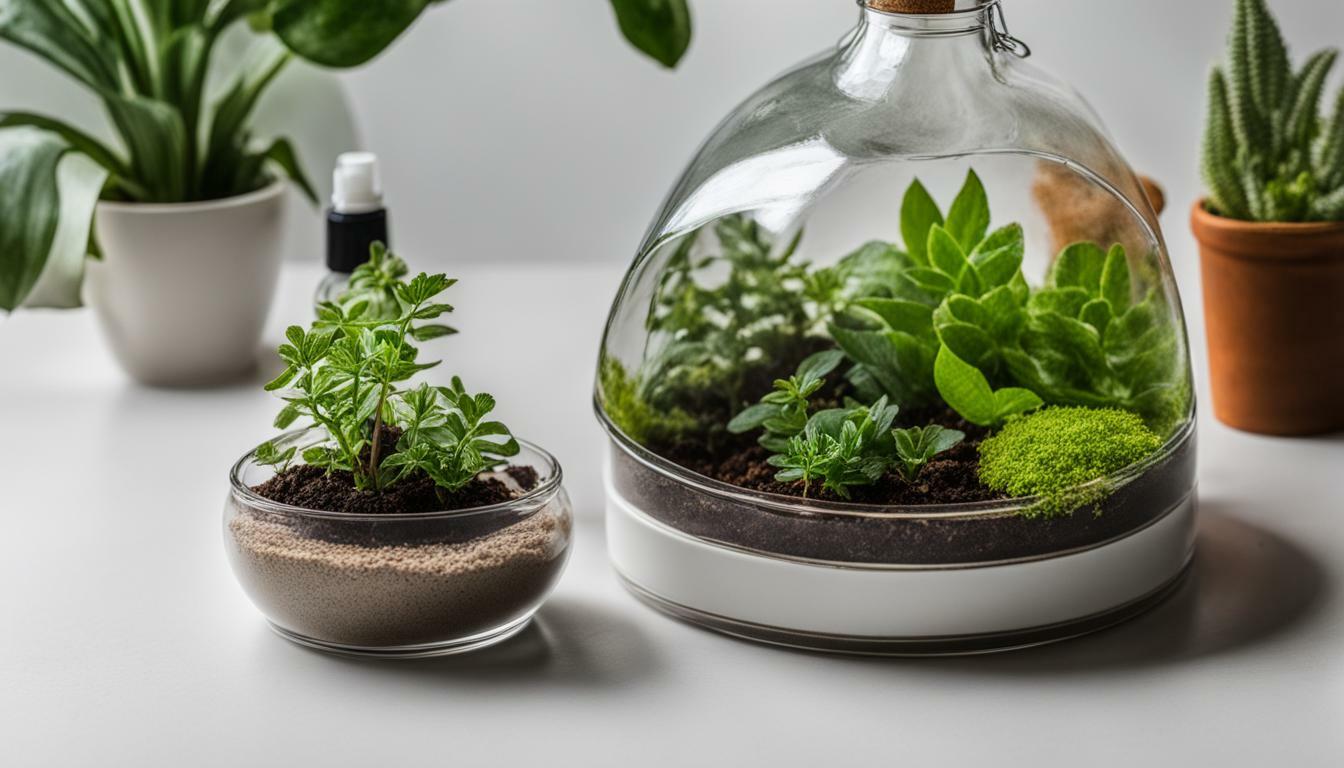Terrariums are a popular way to create a miniature indoor garden, but they can be susceptible to pests if not properly cared for. To ensure your terrarium thrives and remains pest-free, it’s important to follow expert tips on pest control methods. By implementing these strategies, you can create a thriving enclosed ecosystem that will bring beauty and tranquility to your space.
- Avoid placing terrariums in direct sunlight or near a heat source to prevent harm to the plants.
- Trim overgrown plants and remove diseased or dying plants promptly to prevent the spread of pests.
- Regularly clean the glass of the terrarium to ensure optimal light exposure for the plants.
- Use a spray bottle for watering to prevent over-watering and absorb excess water if necessary.
- Select plants that thrive in the specific conditions of your terrarium to minimize pest issues.
Common Mistakes to Avoid in Terrarium Care
Placing terrariums in direct sunlight or near a heat source can harm the plants and create an environment that is conducive to pest infestations. It is important to remember that while natural light is essential for plant growth, direct sunlight can cause excessive heat buildup and damage the delicate ecosystem within the terrarium. To prevent this, place your terrarium in an area with indirect light or use curtains or blinds to filter the sunlight. Additionally, avoid placing your terrarium near radiators, heating vents, or other sources of heat that can disrupt the temperature balance.
Another common mistake is neglecting to trim overgrown plants or removing any diseased or dying plants promptly. Overgrown plants can block airflow within the terrarium, creating a breeding ground for pests. Regularly trim back any excess growth to maintain proper ventilation and ensure that all plants receive adequate light. If you notice any plants showing signs of disease or decay, remove them immediately to prevent the spread of pests or pathogens. Replace them with new plants that have similar requirements to maintain the balance of the ecosystem.
Cleaning the glass of the terrarium is often overlooked but is crucial for optimal plant health and pest control. Over time, dust and grime can accumulate on the inside and outside of the glass, reducing the amount of light that reaches the plants. Regularly clean the glass with a mild glass cleaner or a mixture of vinegar and water to remove any dirt or residue. This will help maintain the clarity of the glass, allowing for maximum light exposure and preventing pests from hiding in the crevices.
Common Mistakes to Avoid in Terrarium Care:
| Mistake | Consequence |
|---|---|
| Placing terrariums in direct sunlight or near a heat source | Can harm the plants and create an environment conducive to pest infestations |
| Neglecting to trim overgrown plants or remove diseased/dying plants | Blocks airflow, provides breeding grounds for pests, and spreads diseases or pathogens |
| Failure to clean the terrarium glass regularly | Reduces light exposure, hinders plant growth, and allows pests to hide |
Avoiding these common mistakes in terrarium care can help prevent pest infestations and ensure the health and vitality of your enclosed ecosystem. By providing the right conditions and maintaining proper care, you can enjoy a thriving terrarium that brings the beauty of nature indoors.
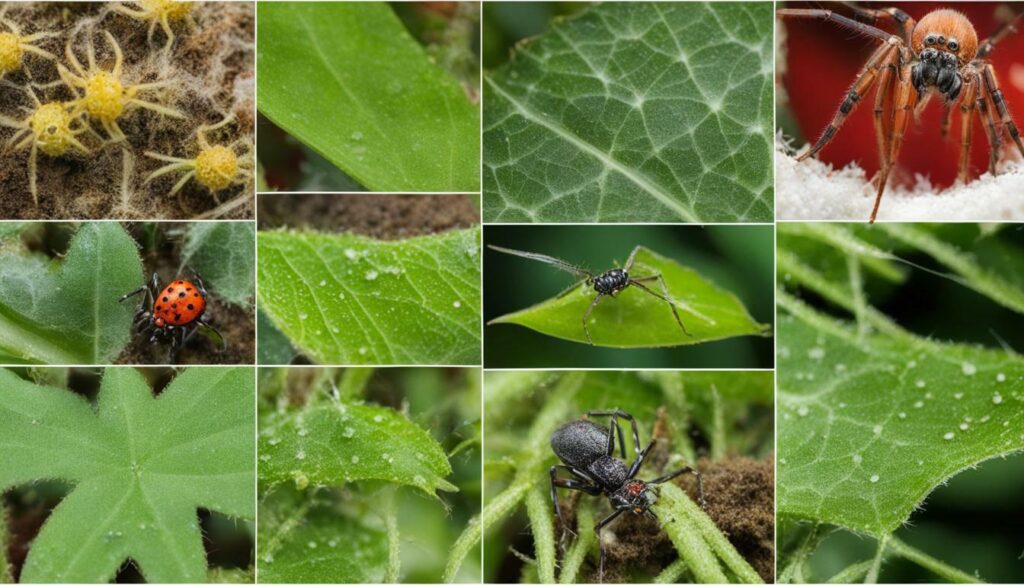
Maintaining Healthy Plants in Your Terrarium
Regularly trimming overgrown plants and promptly removing any diseased or dying plants is essential for preventing the spread of pests in a terrarium. By keeping your plants healthy and thriving, you create an environment that is less attractive to pests and more resistant to infestations.
One important aspect of terrarium care is selecting plants that are well-suited to the specific conditions of your terrarium. Different plants have different requirements in terms of light, humidity, and temperature. For closed terrariums, choose plants that thrive in a moist environment, while low-light terrariums require plants with low-light requirements. By understanding the needs of your plants, you can provide optimal conditions for their growth and reduce the risk of pest problems.
Proper watering techniques are also crucial in maintaining a healthy terrarium. Avoid over-watering by using a spray bottle instead of a watering can. This allows you to control the amount of water you provide and prevent waterlogging, which can lead to root rot and attract pests. If you accidentally over-water your terrarium, absorb the excess water with a paper towel and leave the top off until it dries out.
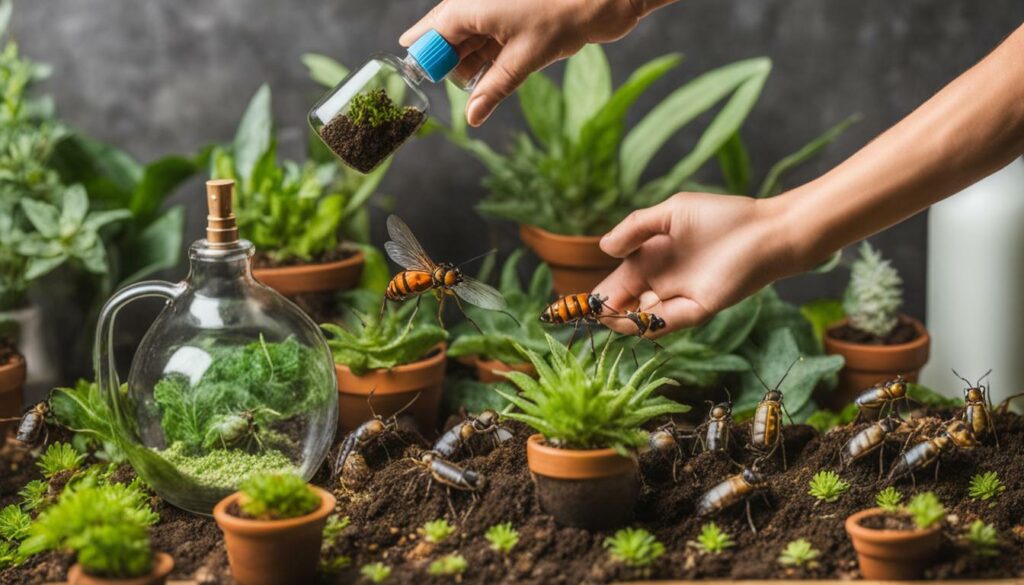
Another important aspect of terrarium care is regular cleaning. Clean the glass of your terrarium inside and out periodically to ensure optimal light exposure for the plants. Dust and debris can block the sunlight and hinder plant growth, making them more vulnerable to pests. Use a soft cloth or sponge to wipe away any dirt or smudges, taking care not to disturb the plants or disturb the ecosystem.
By following these tips for maintaining healthy plants in your terrarium, you can create a vibrant and pest-free enclosed ecosystem. Remember to regularly trim overgrown plants, select the right plants for your terrarium’s conditions, water properly, and keep the glass clean. These simple steps will go a long way in preventing pest problems and ensuring the success of your terrarium.
Proper Cleaning Techniques for Terrariums
Periodically cleaning the glass of your terrarium, both inside and out, will help maintain a healthy environment for your plants and deter pests. Dust and dirt can accumulate on the glass, blocking the light that plants need for photosynthesis. Here are some tips for effectively cleaning your terrarium:
- Gather your supplies: Before you begin, gather the necessary supplies, including a soft cloth or sponge, mild soap or vinegar, and warm water. Avoid using harsh chemicals or abrasive cleaners, as they can damage the glass and harm your plants.
- Remove the plants and decorations: Carefully remove the plants and any decorative items from the terrarium, ensuring delicate roots and leaves are not damaged. Place them in a safe spot where they won’t be exposed to direct sunlight or extreme temperatures.
- Clean the glass: Dip the cloth or sponge in a mixture of mild soap or vinegar and warm water. Gently wipe the glass, both inside and out, removing any dirt or residue. Avoid excessive moisture on the glass surface, as it can promote mold or fungal growth.
- Rinse and dry: Once you have cleaned the glass, rinse it thoroughly with clean water to remove any soap or vinegar residue. Wipe the glass dry with a clean, dry cloth, ensuring there are no streaks or moisture left behind.
- Reassemble the terrarium: Place the clean plants and decorations back into the terrarium, arranging them as desired. Ensure the plants are positioned correctly and have enough space for growth.
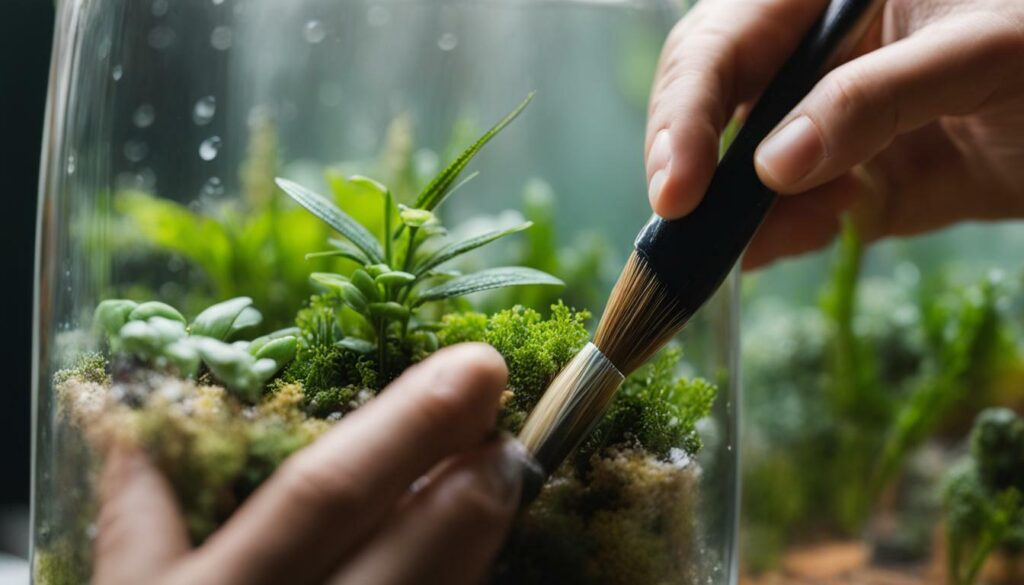
Cleaning your terrarium regularly not only keeps it looking pristine but also ensures optimal plant health and deters pests. A clean environment will promote proper light exposure and reduce the risk of disease and infestations. By following these proper cleaning techniques, you can maintain a thriving and beautiful enclosed ecosystem.
Remember, each terrarium is unique, so it’s essential to consider the specific requirements of your plants and adjust your cleaning routine accordingly. With regular care and maintenance, your terrarium will continue to flourish, bringing you joy and tranquility.
Watering Tips for Terrariums
Using a spray bottle instead of a watering can is recommended to prevent over-watering, which can create a damp environment that attracts pests. Mist the plants lightly, ensuring that the soil is evenly moist but not saturated. If over-watering does occur, absorb the excess water with a paper towel and leave the top off the terrarium until it dries out. This will help maintain the ideal moisture levels and prevent the growth of mold or fungus that can attract pests.
Another watering tip is to water the terrarium plants from the bottom. Place the terrarium in a tray or dish filled with water and allow the plants to soak up the moisture through the drainage holes in the pot. This method allows the plants to take up the water they need without drowning the roots or causing waterlogged soil.
It is essential to monitor the moisture levels within the terrarium regularly. Stick your finger into the soil to check if it feels dry before watering again. Remember that different terrariums and plant species have varying water requirements, so adjust your watering routine accordingly.
| Watering Tip | Effect |
|---|---|
| Use a spray bottle | Prevents over-watering and creates a suitable moisture level |
| Water from the bottom | Avoids waterlogging and allows plants to soak up moisture |
| Monitor moisture levels | Prevents under or over-watering and adjusts watering frequency |
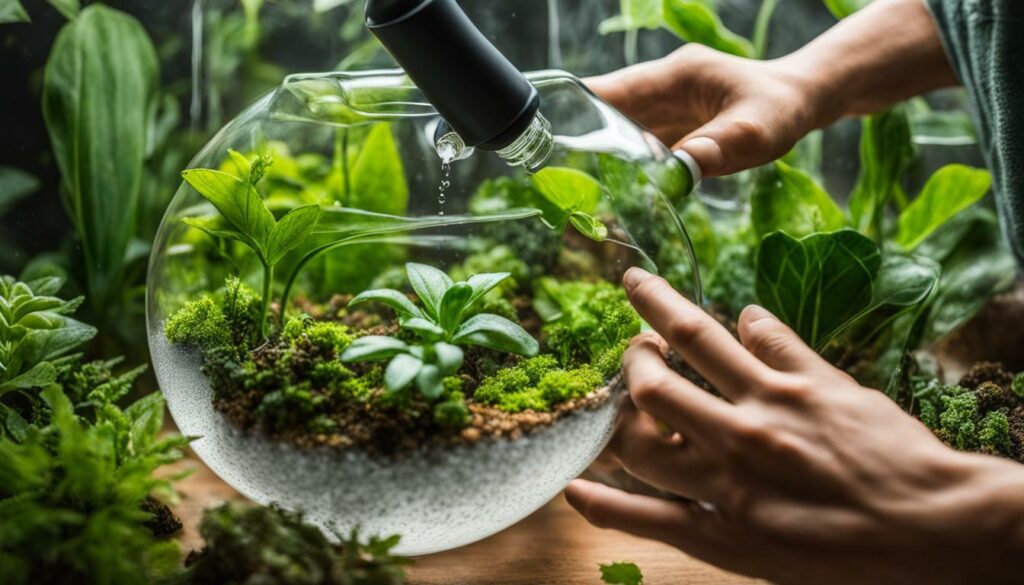
“Using a spray bottle instead of a watering can is recommended to prevent over-watering, which can create a damp environment that attracts pests.”
By following these watering tips, you can maintain the optimal moisture levels in your terrarium and prevent pest infestations. Remember to pay attention to your plant’s water requirements, as different species may have specific needs. With proper watering techniques, your terrarium will thrive, creating a beautiful and pest-free enclosed ecosystem.
Choosing the Right Plants for Your Terrarium
Choosing plants that thrive in the specific conditions of your terrarium, such as those that prefer a moist environment or low-light conditions, can promote a healthy ecosystem and minimize pest problems. It is important to consider the size, growth rate, and care requirements of the plants when selecting them for your terrarium. Here are some popular terrarium plants to consider:
- Ferns: Ferns are excellent choices for closed terrariums as they thrive in high humidity and low light conditions. Their delicate foliage adds a touch of elegance to the enclosed ecosystem.
- Moss: Moss is a versatile plant that can be used to create lush landscapes in your terrarium. It thrives in moist conditions and helps retain moisture, creating a favorable environment for other plants.
- Succulents: If you have an open terrarium or prefer a drier environment, succulents are a great option. They require less frequent watering and can tolerate higher light levels.
- Air Plants: Air plants, also known as Tillandsias, are unique plants that don’t require soil to grow. They can be attached to various surfaces in your terrarium, adding a touch of whimsy and variety.
Remember to research the specific care requirements of each plant before adding them to your terrarium. This will ensure that they receive the proper amount of water, light, and nutrients for optimal growth. Additionally, regularly inspect your plants for signs of pests or diseases, and promptly address any issues to prevent further damage.
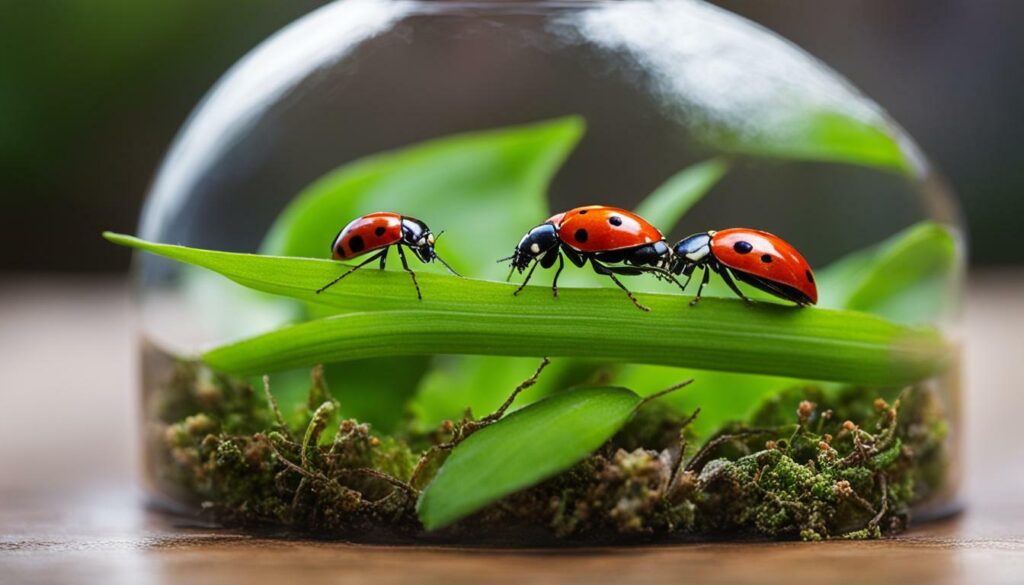
Adding live plants to your terrarium not only enhances its aesthetic appeal but also contributes to its overall health and balance. With the right plants and proper care, you can create a thriving ecosystem that is resilient to pest problems. Take the time to select plants that suit your terrarium’s environment and enjoy the beauty and tranquility they bring.
| Plant | Light Requirements | Watering Needs | Special Considerations |
|---|---|---|---|
| Ferns | Low to medium light | Moderate | High humidity |
| Moss | Low light | Minimal | Retains moisture |
| Succulents | Medium to high light | Infrequent | Well-draining soil |
| Air Plants | Medium to high light | Light misting | No soil required |
Preventing Mite Infestations in Terrariums
Mite infestations can be a common problem in terrariums, but by following proper maintenance practices, you can minimize the risk. These tiny insects are known to feed on plant material, causing damage and potentially spreading to other plants within the enclosure. Here are some strategies to help prevent mite infestations in your terrarium:
Maintain Proper Humidity and Temperature Levels
Mites thrive in warm and humid conditions, so it’s important to keep your terrarium’s environment within the optimal range for your plants. Monitor the humidity levels using a hygrometer, and use a misting bottle to adjust the moisture as needed. Additionally, be mindful of the temperature, as mites can reproduce rapidly in warmer temperatures. Consider placing your terrarium away from direct sunlight and heat sources to help maintain a stable climate.
Regularly Clean and Remove Food Debris
Keeping your terrarium clean is crucial in preventing mite infestations. Regularly inspect the plants and remove any fallen leaves or decaying material, as these can be food sources for mites. Use a soft cloth or sponge to clean the glass both inside and out, ensuring optimal light exposure for the plants and eliminating any potential hiding spots for pests.
Ensure Proper Ventilation and Airflow
Good airflow helps to discourage mites from settling in your terrarium. Ensure there is adequate ventilation by providing small openings or gaps in the terrarium’s lid or sides. This will allow fresh air to circulate, preventing the buildup of stagnant air that can create a favorable environment for mites. However, be cautious not to create large openings that may allow other unwanted pests to enter.
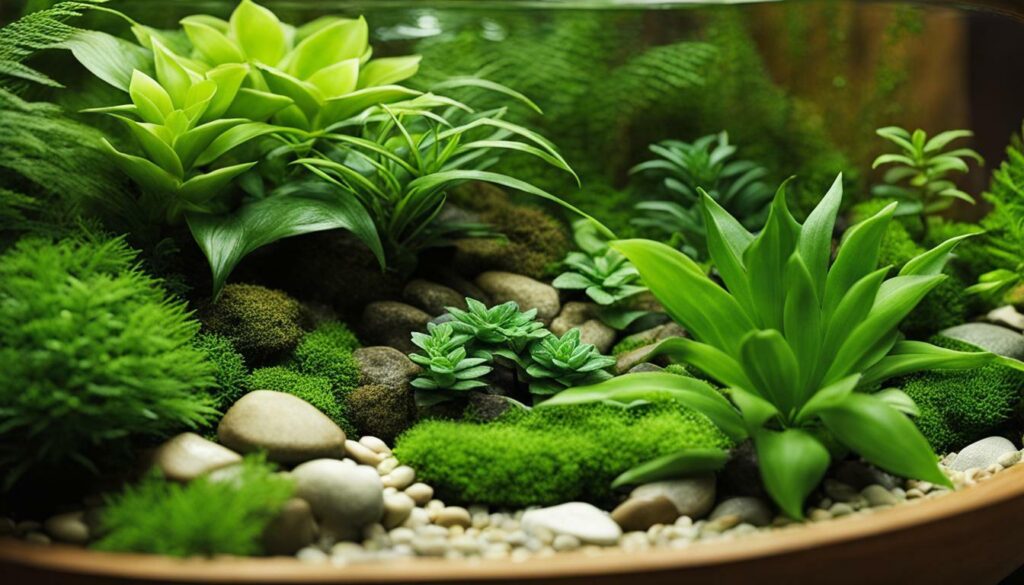
By incorporating these preventive measures into your terrarium care routine, you can significantly reduce the risk of mite infestations. Remember to regularly inspect your plants for any signs of pests and promptly address any issues that arise to ensure the health and longevity of your enclosed ecosystem.
| Preventive Measures | Benefits |
|---|---|
| Maintain proper humidity and temperature levels | Creates an unfavorable environment for mites to thrive |
| Regularly clean and remove food debris | Eliminates potential food sources for mites |
| Ensure proper ventilation and airflow | Discourages mites from settling in the terrarium |
Natural Pest Control Solutions for Terrariums
Predatory mites are a natural and safe solution for controlling mite infestations in terrariums without causing harm to other inhabitants. These tiny beneficial mites feed on harmful pests, such as spider mites, thrips, and fungus gnats, helping to keep your terrarium free from infestations.
To introduce predatory mites into your terrarium, you can purchase them from specialized garden centers or online suppliers. Follow the instructions provided with the mites for the correct release rate based on the size of your terrarium. It’s important to release the mites when the pest population is low to ensure they have enough food to sustain themselves.
Once released, the predatory mites will actively search for pests and feed on them, reducing their populations. The mites are effective at controlling mites at all stages of their life cycle, including eggs, larvae, and adults. They reproduce quickly and can establish a self-sustaining population within the terrarium if the conditions are favorable.
| Predatory Mite Species | Target Pests |
|---|---|
| Phytoseiulus persimilis | Spider mites |
| Hypoaspis miles | Fungus gnats, springtails |
| Amblyseius swirskii | Thrips, whiteflies |
In addition to using predatory mites, it’s essential to create an environment in your terrarium that is unfavorable for pests. Avoid overwatering, as excess moisture can attract pests. Clean the terrarium regularly, removing any debris or decaying plant matter that can serve as a food source for pests. Providing adequate ventilation and airflow will also help prevent mite infestations.
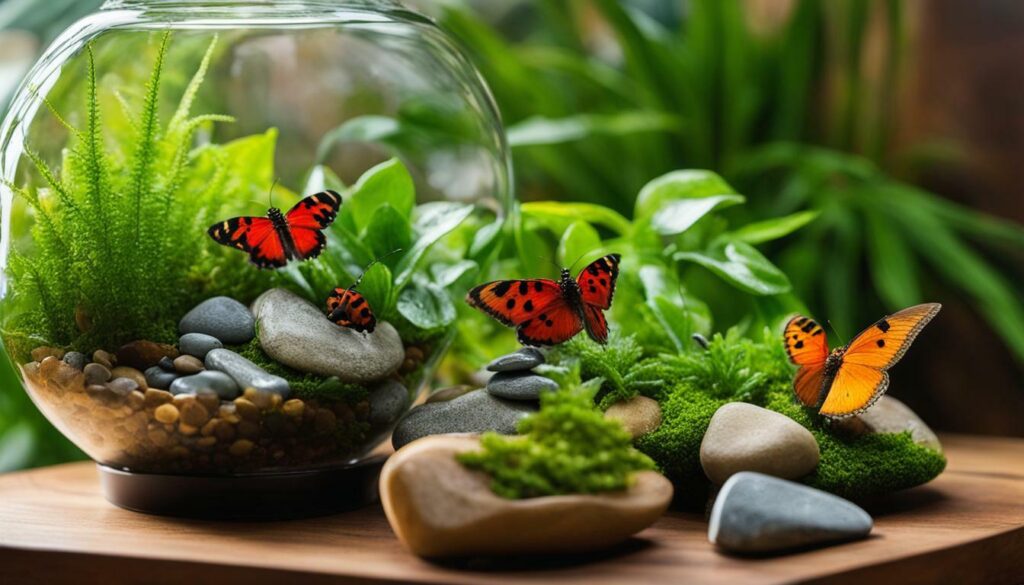
By incorporating these natural pest control methods into your terrarium care routine, you can maintain a healthy and pest-free enclosed ecosystem. Remember to monitor your terrarium regularly and take swift action at the first sign of any pest issues. With proper care and attention, your terrarium will thrive and bring you joy for years to come.
What are the best pest control methods for terrarium care?
When it comes to effective terrarium light care explained, there are a few key pest control methods to keep in mind. Using natural predators like ladybugs or practicing good plant hygiene by regularly removing dead leaves can help prevent infestations. Additionally, using sticky traps or neem oil can also effectively control pests.
Conclusion
By following these expert tips on terrarium care pest control methods, you can create a thriving enclosed ecosystem while keeping pesky pests at bay. Avoid common mistakes like placing your terrarium in direct sunlight or near a heat source, as this can harm the plants. Instead, provide the right conditions for your plants by maintaining proper humidity and temperature levels.
Regular cleaning is essential to prevent pest infestations. Clean the glass of your terrarium inside and out periodically to ensure optimal light exposure for your plants. Trim overgrown plants and remove any diseased or dying plants immediately to prevent spreading and replace them with healthy specimens.
Watering your terrarium properly is also crucial in pest control. Instead of using a watering can, opt for a spray bottle to prevent over-watering. If you do over-water, absorb the excess water with a paper towel and leave the top off the terrarium until it dries out.
Lastly, choosing the right plants for your terrarium is key to maintaining a healthy environment. Select plants that thrive in the specific conditions of your terrarium, such as those that prefer a moist environment for closed terrariums or plants with low-light requirements for low-light terrariums. By following these tips, you can create a beautiful and pest-free terrarium that will flourish for years to come.
FAQ
What are some common mistakes to avoid in terrarium care?
It is important to avoid placing terrariums in direct sunlight or near a heat source, as this can harm the plants. Additionally, removing overgrown or diseased plants immediately and replacing them with healthy plants is necessary to prevent spreading and maintain a thriving ecosystem.
How should I clean my terrarium?
Periodically cleaning the glass of your terrarium, both inside and out, ensures optimal light exposure for the plants. Wiping down the glass with a soft cloth or paper towel and a mild glass cleaner is recommended.
What is the best way to water a terrarium?
It is advisable to use a spray bottle instead of a watering can to prevent over-watering. If over-watering does occur, absorb the excess water with a paper towel and leave the top of the terrarium off until it dries out.
How can I prevent mite infestations in my terrarium?
To prevent mite infestations, it is important to maintain proper humidity and temperature levels, regularly clean the terrarium and remove any food debris, and ensure proper ventilation and airflow.
Are there any natural pest control solutions for terrariums?
Yes, predatory mites can be used as a natural and safe solution for controlling mite infestations in terrariums, without harming other inhabitants. They can help keep the pest population in check.

